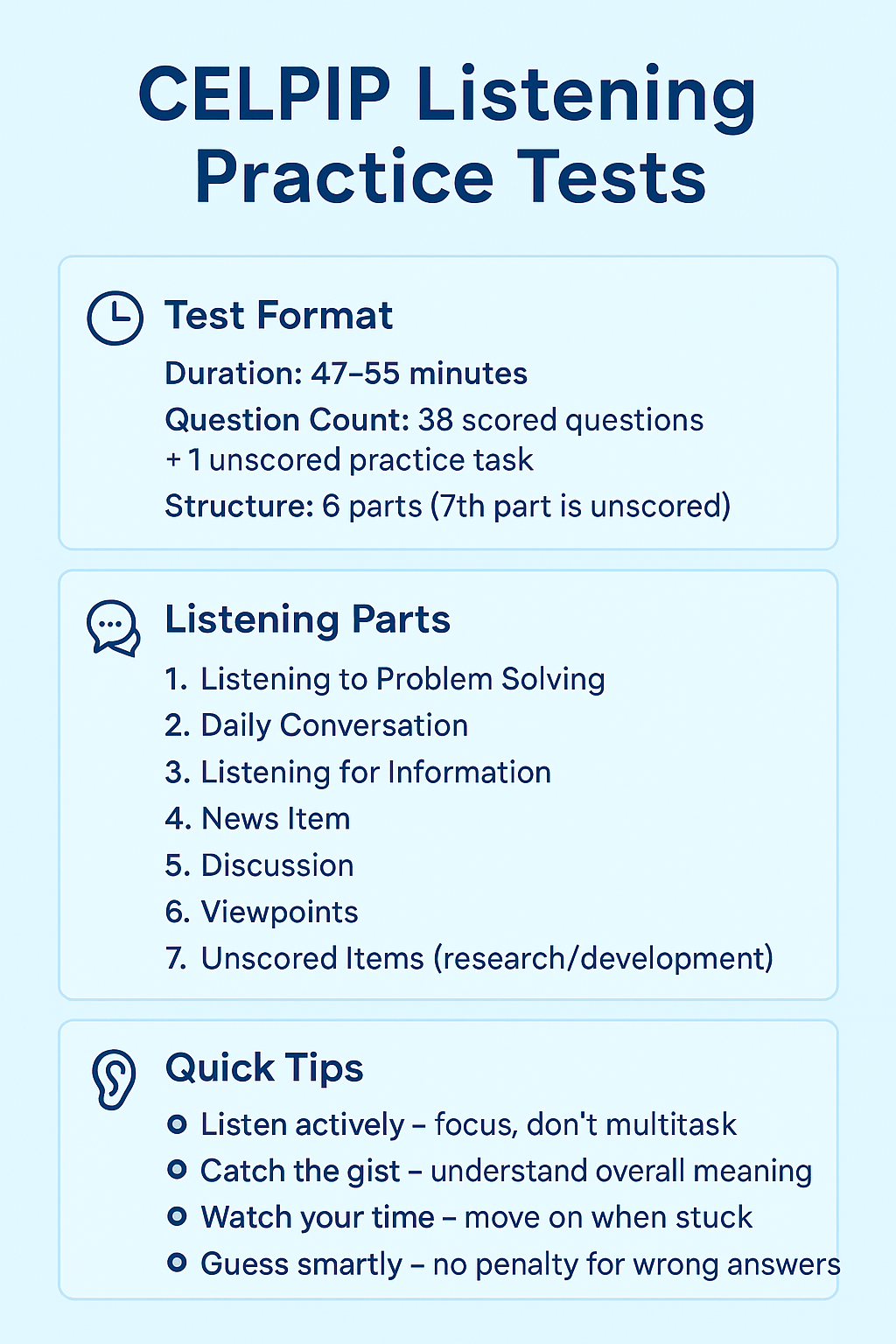Sharpen yourself with Celpip Listening Practice Tests and improve comprehension. Start acing the Celpip Listening Section today!
CELPIP Listening Practice Task Sample
| Celpip Listening Practice Sample 1: |
CELPIP Listening to Problem Solving Sample
CELPIP Listening to a Daily Life Conversation Sample
CELPIP Listening for Information Sample
CELPIP Listening to a News Item Sample
CELPIP Listening to a Discussion Sample
CELPIP Listening to Viewpoints Sample
Here is the detailed Information on Celpip Listening Practice Tests
Hey there! If you’re gearing up for the CELPIP Listening test, you’re in the right spot. As someone who has coached hundreds of individuals just like you—immigrants chasing the Canadian dream or professionals aiming for better opportunities—I’ve seen how this section can feel tricky but is totally conquerable.
The Canadian English Language Proficiency Index Program (CELPIP) is all about real-life English, and the Listening part checks how well you catch everyday chats, news, and opinions.
Good news: As of August 2025, the test format remains unchanged from its reliable structure. However, there’s a fresh update—CELPIP is now accepted for Australian visa purposes as well, opening doors in Australia if Canada’s not your only plan.
Let’s keep it simple: I’ll walk you through the setup, share practice samples with real examples, and drop tips that work. We’ll make this engaging, like we’re chatting over coffee.
Quick Peek at the CELPIP Listening Test in 2025
The Listening section lasts approximately 47-55 minutes, comprising 38 scored questions (plus a warm-up). It’s computer-based, with audio playing once, and you can jot down notes—super handy!
There are no significant changes in the format this year; it remains six parts, aligning with the Canadian Language Benchmarks (CLB) for immigration purposes. Score reports got a tweak back in 2023 for more explicit CLB mapping, but that’s old news now.
Both CELPIP General (full test) and General LS (Listening and Speaking only) include this section, so don’t skip it if Canada’s calling.
Here’s the breakdown:
- Part 1: Listening to Problem Solving – 8 questions, short dialogues fixing issues.
- Part 2: Listening to a Daily Life Conversation – 5 questions, casual talks.
- Part 3: Listening for Information – 6 questions, fact-packed monologues.
- Part 4: Listening to a News Item – 5 questions, quick news reports.
- Part 5: Listening to a Discussion – 8 questions, group chats with video.
- Part 6: Listening to Viewpoints – 6 questions, opinion showdowns.
Pro tip: Questions ramp up in toughness, so start strong!

Practice Samples to Get You Started
Practice makes perfect, right? Drawing from sources like celpip.biz, I’ve compiled samples for each part. I’ve added fresh examples below to make it real—think scenarios you’d hear in Canada. Listen up (pun intended) and note key details.
Practice Task Sample
This is your easy intro.
Example: A proctor says, “Adjust your volume now.”
Question: What’s the first step?
(A: Check audio).
Focus: Get comfy with the setup.
1. Listening to Problem-Solving Samples
7 samples here, like quick fixes in dialogues (90 seconds each).
Example Scenario: A shopper calls about a wrong order. Clerk offers a swap or a refund. Question: What’s the clerk’s first suggestion?
(B: Exchange it tomorrow).
2. Listening to a Daily Life Conversation Sample
10 samples of buddy talks (2 minutes).
Example Scenario: Pals plan a BBQ, but one’s allergic to nuts.
Question: Why skip the park?
(C: Too buggy). Listen for vibes—like excitement or hesitation.
3. Listening for Information Samples
11 samples with info dumps (2.5 minutes).
Example Scenario: Talk on Toronto’s transit system, listing routes and fares.
Question: What’s the subway’s peak hour?
(A: 7-9 AM). Note facts like “TTC: $3.25 fare”.
4. Listening to a News Item Samples
8 samples of reports (1.5 minutes).
Example Scenario: News on a Vancouver festival starting Sept 15.
Question: Event date?
(C: September 15). Grab dates fast—”fest: Van, Sept 15″.
5. Listening to a Discussion Samples
6 samples with video groups (2 minutes).
Example Scenario: Team debates eco-friendly offices—solar panels vs. recycling.
Question: Who backs solar?
(B: Lisa). Watch body language; note “Lisa: solar pros”.
6. Listening to Viewpoints Samples
6 samples of opinions (3 minutes).
Example Scenario: Views on hybrid work: One loves flexibility, another misses team vibes.
Question: Second speaker’s worry?
(B: Less collaboration). Track “Spkr2: collab down”. Toughest—breathe and focus!
8 Tips to Boost Your Score (With 2025 Twists)
I’ve refined these based on what works now—folks acing it with AI practice apps and diverse accents. Let’s keep it real:
- Know the Structure Inside Out: Map it like above. No changes in 2025, so focus on flow.
- Listen Like Your Future Depends on It: Audio once—catch tones! Practice in cafes to mimic noisy rooms. Example: In a news clip, a sarcastic “Great weather” means rain.
- Master Your Time: 30 seconds average? Skip stuck spots, eye the timer. One student finished early by practicing mocks daily.
- Guess Smart: No penalties—go for it! A lucky pick bumped my client’s score from 8 to 9.
- Note Like a Pro: Abbreviations rule. In info parts, scribble “date: Aug 11” for quick recall.
- Chill Out: Deep breaths pre-test. Anxiety? Visualize success—works wonders.
- Review if You Can: Double-check for slips, like wrong speaker IDs.
- Extra Gems: Read instructions, test headphones, get computer-savvy. Hit up coaching for accents; with Australian acceptance, more global prep resources are popping up. Do tons of samples from celpip.biz—aim for 20 a week.
CELPIP Listening can be tough for non-natives, but with practice, you’ll master it. One client went from nervous wreck to CLB 10 by noting details and relaxing. You’ve got this—grab those samples, stay updated, and let’s chat if you need more!


